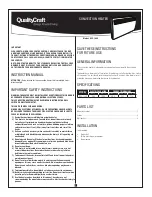
Manual 2100-703H
Page
5 of 42
Refer to the Maximum ESP of Operation table on page
38.
Design the duct work according to methods given by
the Air Conditioning Contractors of America (ACCA).
When duct runs through unheated spaces, it should
be insulated with a minimum of 1" of insulation. Use
insulation with a vapor barrier on the outside of the
insulation. Flexible joints should be used to connect
the duct work to the equipment in order to keep the
noise transmission to a minimum.
Models W18 and W24 are approved for 0" clearance
to the supply duct. For models W30 and W36, a 1/4"
clearance to combustible material for the first 3' of
duct attached to the outlet air frame is required. See
Ducted Applications
on page 7 and Figures 3A and 3B
(pages 10 and 11) and Figure 4 (page 12) for further
details.
Ducts through the walls must be insulated and all joints
taped or sealed to prevent air or moisture entering the
wall cavity.
Some installations may not require any return air duct.
A metallic return air grille is required with installations
not requiring a return air duct. The spacing between
louvers on the grille shall not be larger than 5/8".
Any grille that meets with 5/8" louver criteria may be
used. It is recommended that Bard Return Air Grille
Kit RG-2W through RG-3W or RFG-2W through RFG-
3W be installed when no return duct is used. Contact
distributor or factory for ordering information. If using a
return air filter grille, filters must be of sufficient size to
allow a maximum velocity of 400 fpm.
NOTE:
If no return air duct is used, applicable
installation codes may limit this cabinet to
installation only in a single story structure.
Filters
A 1" throwaway filter is standard with each unit. The
filter slides into position making it easy to service. This
filter can be serviced from the outside by removing the
filter access panel. A 1" washable filter and 2" pleated
filter are also available as optional accessories. The
internal filter brackets are adjustable to accommodate
the 2" filter by bending two tabs down on each side of
the filter support bracket.
Fresh Air Intake
All units are built with fresh air inlet slots punched in
the service door.
If the unit is equipped with a fresh air damper
assembly, the assembly is shipped already attached
to the unit. The damper blade is locked in the closed
position. To allow the damper to operate, the maximum
and minimum blade position stops must be installed
(see Figure 1).
Graphs found on pages 41 and 42 give approximate
fresh air amounts based on the blade position stop
location.
All capacity, efficiency and cost of operation
information is based upon the fresh air blank-off plate
in place and is recommended for maximum energy
efficiency.
The blank-off plate is available upon request from the
factory and is installed in place of the fresh air damper
shipped with each unit.
MIS-938
FIGURE 1
Fresh Air Damper
BLADE IS LOCKED CLOSED
FOR SHIPPING






































